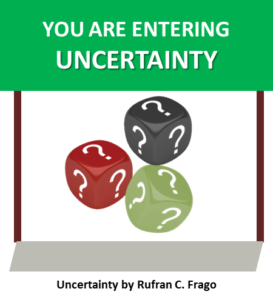 The phrase “science in managing black swans” can be contentious, as there is none yet. I guess it is a statement anticipating a future where the science to successfully predict these events becomes available.
The phrase “science in managing black swans” can be contentious, as there is none yet. I guess it is a statement anticipating a future where the science to successfully predict these events becomes available.
The core of any black swan discussion these days is finding a way to identify it by using big data, so that risk managers can manage the risk the moment black swans become known. The intention is practically removing the black swan status.There is great potential for successfully foretelling black swan events through science. We are not there yet, but it is bound to happen. If those unknown events suddenly become visible, known, and predictable through the science of data analytics, then they cease to be black swans.
They move from unknown-unknown to known-unknown to known-known. Unfortunately, today’s methods and tool sets are still in their infancy despite the relative leaps in our thinking process, systems, structures, and technologies. As such, the science for managing black swans is still under development. I do agree, and even the experts must admit, that, at present, the science is still not there.
“…when experts investigate catastrophic black swan events, be they airline crashes, financial crises, or terrorist attacks, they often find that we failed to anticipate them even when the needed information was present because the data was spread across different organizations and was never properly brought together… In addition to having a solid foundation in statistics, math, data engineering and computer science, data scientists must also have expertise in some particular industry or business domain, so they can properly identify the important problems to solve in a given area and the kinds of answers one should be looking for. Domain expertise is also needed to be able to draw the proper conclusions from their analysis, and to communicate their findings to business leaders in their own terms (Wladawsky-Berger, 2013).”
If an observer does not know and has no expectation of the risk whatsoever, the event to him/her is unknown.
In the same sense, the assessment of the impact component of risk is also relative to the observer’s goals and interests. An event that might be major to one group can be a non-event to another group. A threat to one can be an opportunity to another depending on the individual intentions.
Unknown unknowns (black swans) might be in the room, for all we know, but we just cannot see them until circumstances make them visible. Once we see that the risk exists, we would surmise that it no longer qualifies as a black swan event, because we are now aware of the risk, and the element of surprise is no longer there. It is now the normal type of risk that many risk managers are already familiar with, the known unknowns.
The risk universe is immense, yet each component, regardless of how small it might be, can affect the results. If we put a bracket to what data we analyze, then we do not have the whole picture. If we do not put a bracket of limitation to what we evaluate, then we are analyzing infinity and we will not arrive at a more reliable answer. We are talking about a great and expansive risk network that trumps common comprehension.
Source:
Rufran C. Frago-Author
https://www.amazon.com/author/rufrancfrago
https://youtu.be/LDESPW6OYkg
Indigo/Chapters
Related sites:
Your World, Our Risk Universe: WordPress
LinkedIn Professional Website
Other books authored by Rufran Frago
Plan to Schedule, Schedule to Plan.ISBN 978-0-9947608-2-1.Canada
How to Create a Good Quality P50 Risk-based Baseline Schedule.ISBN 978-0-9947608-1-4.Canada
How to Create a Good Quality P50 Risk-based Baseline Schedule

